|
|
|
Sort Order |
|
|
|
Items / Page
|
|
|
|
|
|
|
| Srl | Item |
| 1 |
ID:
164604
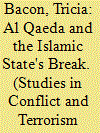

|
|
|
|
|
| Summary/Abstract |
Employing counterfactuals to assess individual and systemic explanations for the split between Al Qaeda and the Islamic State of Iraq and al-Sham (ISIS), this article concludes that individual leaders factor greatly into terrorist alliance outcomes. Osama bin Laden was instrumental in keeping Al Qaeda and ISIS allied as he prioritized unity and handled internal disputes more deftly than his successor, Dr. Ayman al-Zawahiri. Although a troubled alliance, strategic differences between Al Qaeda and ISIS were not sufficient to cause the split. Rather, the capabilities of Al Qaeda's leader determined the group's ability to prevent alliance ruptures.
|
|
|
|
|
|
|
|
|
|
|
|
|
|
|
|
| 2 |
ID:
193069
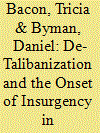

|
|
|
|
|
| Summary/Abstract |
This article examines the reasons for the rise of the Taliban and the onset of the insurgency in Afghanistan after the 2001 U.S. invasion, using counterfactual and path dependence analysis to bolster its arguments. We argue that the U.S. decision to de-Talibanize was a critical juncture, after which the rise of insurgency was far harder to prevent. The total rejection of the Taliban translated into the under-representation of Pashtuns in the Afghan government, delivering power to ethnic minorities at their expense. De-Talibanization led the United States to support strongmen to hunt the Taliban, but they were predatory, creating grievances that the Taliban exploited to recruit. Finally, de-Talibanization led many Taliban to flee to Pakistan, pushing them into the country most opposed to Afghanistan new political order. The lessons of the U.S. experience in Afghanistan suggest the necessity of a strategy for managing defeated enemies after an initial military victory.
|
|
|
|
|
|
|
|
|
|
|
|
|
|
|
|
| 3 |
ID:
137159


|
|
|
|
|
| Summary/Abstract |
Terrorist organizations’ physical safe havens continue to shape the terrorist threat to the United States by extending the groups’ longevity and increasing the threat they pose. As a result, eliminating terrorist safe havens has been a key component of U.S. counterterrorism policy since at least 2001. However, some scholars challenged the post-9/11 policy consensus that terrorists find sanctuary in weak states and so-called ungoverned spaces. This article seeks to bridge this gap between scholarship and policy by offering a typology for disaggregating different kinds of terrorist safe havens. Our typology operates on two axes based on host government will (i.e., the host government's posture toward each group with haven inside its borders), as well as government capability, (specifically whether the host government possesses the specific capabilities needed to oust each group). This intersection of will and capability produces three types of havens. We briefly illustrate each type of haven using the exemplar case study of Pakistan—a location often described as an overarching safe haven, but which is actually home to several sanctuaries—and offer policy recommendations for addressing them. A need exists to disaggregate and identify how the United States can approach haven elimination. This typology and the analysis that stems from it offer a starting point for devising such strategies.
|
|
|
|
|
|
|
|
|
|
|
|
|
|
|
|
| 4 |
ID:
168855
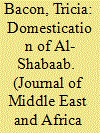

|
|
|
|
|
| Summary/Abstract |
How much influence did foreign fighters exert over al-Shabaab’s insurgency in Somalia? An emerging policy consensus is that foreign fighters exert decisive influence on insurgencies, even affecting conflict duration, intensity, and outcomes. Nevertheless this study argues that foreign combatants in Somalia have exerted a more limited influence than this consensus suggests, though this influence has varied over time. Foreign fighters were present within al-Shabaab from its inception, and remain a part of the group over ten years later. Over this period, non-Somali combatants enjoyed the most influence during the insurgency against Ethiopian forces between 2007 and 2008, when al-Shabaab was a young organization facing a superior enemy. Over time, foreign fighters’ influence within the insurgency in Somalia diminished as al-Shabaab became “domesticated,” i.e. gained controlled of territory and began to govern. This study examines four periods in recent Somali history: the Islamic Court Union’s rise pre-2006, the Ethiopian invasion from 2007 to 2008, al-Shabaab’s territorial conquests from 2009 to 2010, and the internal divisions and purge from 2011 to 2013. This article concludes with a word of caution on the growing perceptions that foreign fighters shape insurgencies and that their involvement significantly helps or hurts local opposition movements. In the case of al-Shabaab’s insurgency in Somalia, transnational insurgents shaped external actors’ calculus in ways that have affected the conflict’s duration, intensity, and even outcomes, but they did not have a commensurate impact within the insurgency.
|
|
|
|
|
|
|
|
|
|
|
|
|
|
|
|
| 5 |
ID:
170139
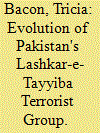

|
|
|
| 6 |
ID:
192155
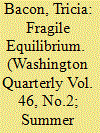

|
|
|
|
|
| Summary/Abstract |
It makes sense that the United States has significantly downgraded relations with Pakistan since the withdrawal from Afghanistan. The anger in Washington toward Islamabad for its support of the Afghan Taliban during the US war was palpable and justified. Absent a need to rely on Pakistan to access Afghanistan to prosecute the war, and with the broader decline of counterterrorism as a priority, the US only sees the need for a minimum viable bilateral relationship. The US shift to near peer competition has exacerbated the distance as Pakistan’s close relationship with China—now the preeminent US national security concern—is juxtaposed with US efforts to foster closer ties with Pakistan’s rival, India, as a regional counterweight to China.
|
|
|
|
|
|
|
|
|
|
|
|
|
|
|
|
| 7 |
ID:
190776


|
|
|
|
|
| Summary/Abstract |
How do foreign fighters affect militant group behavior? Recent studies have examined the impact of foreign fighters on broader conflict outcomes, but we explore their specific impact on group behavior. Using foreign fighter data, we find that the presence of foreign fighters is positively related to group longevity, use of suicide operations, and the geographic spread of its operations. We elaborate on these findings in a case study of foreign fighters in al-Shabaab. This article provides important contributions to both scholarship and policy, elucidating the ideological and logistical impact of foreign fighters on tactics, target choices, and group lifespan.
|
|
|
|
|
|
|
|
|
|
|
|
|
|
|
|
| 8 |
ID:
152863
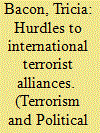

|
|
|
|
|
| Summary/Abstract |
Despite the threat posed by international terrorist alliances, the conditions that foster and inhibit these relationships remain poorly understood. When seeking allies outside of their primary conflict and political market, groups struggle to forge credible commitments, particularly the requisite ‘shadows of the future’ and reputations conducive to cooperation, without third-party enforcers. Given their suspicious nature and strong in-group identities, terrorist groups sometimes balk at relinquishing independence for security. Alliances risk precipitating counterterrorism pressure, alienating constituents, and increasing the risk of betrayal. Even groups that enjoy alliance success, like Al Qaeda, experience these hurdles in their alliance. What helped to set Al Qaeda apart from most groups was its ability to navigate these obstacles, though some bedeviled its alliances efforts. This offers under-utilized opportunities for alliance disruption.
|
|
|
|
|
|
|
|
|
|
|
|
|
|
|
|
| 9 |
ID:
160739
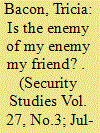

|
|
|
|
|
| Summary/Abstract |
The terrorist organizations that have posed the greatest threat to international security are those with allies. Terrorist groups at the core of alliance networks, particularly the Islamic State and al Qaeda, define the threat today, as they are able to accrue and disperse the benefits of their alliances—including greater lethality, longevity, and resilience—to their partners. While the consequences of these alliances are clear, their causes remain poorly understood, especially with respect to why terrorist alliances cluster around a small number of organizations. I propose that groups ally with the organization at the core of a network to address organizational deficits. In addition, the prospective partners must have both complementary needs and the ability to link their ideologies and frames to build a shared identity. Finally, groups must overcome their inherent suspicions and build trust to ally. These three mechanisms lead to alliance formation, but they also offer numerous avenues for disruption.
|
|
|
|
|
|
|
|
|
|
|
|
|
|
|
|
| 10 |
ID:
165276
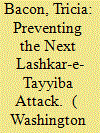

|
|
|
|
|
|
|
|